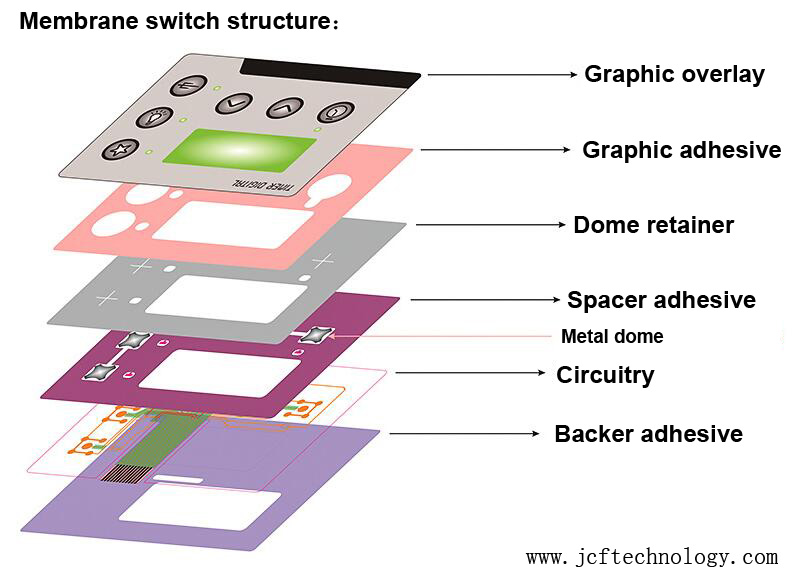Membrane Switch: A Comprehensive Guide to Its Uses and Applications
Membrane Switch: A Comprehensive Guide to Its Uses and Applications
Blog Article
Comprehending Membrane Switches Over: The Key to Dependable and sturdy Controls

What Are Membrane Layer Switches?
Membrane layer buttons are a sophisticated option in the realm of individual interface innovation, combining functionality and style effortlessly. These tools work as an interface in between customers and digital systems, integrating numerous parts into a compact format. Normally built from flexible, slim layers of products, membrane layer buttons are created to reply to touch, allowing users to communicate with machinery and digital devices effectively.
The key aspects of a membrane layer switch include a published circuit layer, visuals overlay, and a spacer layer that avoids unintended activation. The graphic overlay can be customized to reflect brand identity or individual preferences, enhancing appearances while guaranteeing use. Membrane buttons are typically utilized in numerous applications, consisting of medical tools, consumer electronics, and commercial tools, owing to their toughness and resistance to ecological elements such as wetness and dust.
One of the essential benefits of membrane layer switches is their ability to hold up against wear and tear, making them excellent for high-traffic atmospheres. Furthermore, they are light-weight and require marginal space, permitting ingenious layouts in item development. On the whole, membrane layer switches represent a effective and useful option for modern electronic interfaces, marrying technology with user-centric layout concepts.
Just How Membrane Layer Changes Job
The procedure of membrane layer switches over hinges on a simple yet efficient mechanism that translates user input right into digital signals. These switches contain numerous layers, usually consisting of a graphic overlay, a spacer layer, and a circuit layer. When an individual presses the switch, the top layer deforms, enabling a conductive element in the circuit layer to make call with an equivalent conductive pad on the underside of the visuals overlay. This get in touch with closes the circuit and sends a digital signal to the device, indicating that the button has been activated.
The layout of membrane buttons can vary, however they often incorporate domes or tactile components to offer responses to the user, boosting the overall experience - membrane switch. The materials used in membrane layer switches, such as polyester or polycarbonate, contribute to their toughness and resistance to ecological elements, consisting of moisture and dust. The printed circuits are commonly enveloped, which safeguards them from wear and tear over time.
Benefits of Membrane Layer Buttons

Additionally, membrane layer switches are understood for their sturdiness. Built from durable products, they are immune to dirt, dampness, and physical wear, which significantly extends their lifespan compared to traditional mechanical buttons. This sturdiness makes them specifically suitable for high-traffic environments and applications needing longevity.
One more substantial benefit is the convenience of cleaning and upkeep. The smooth surface of membrane layer switches reduces dust accumulation and is typically unsusceptible spills, making them perfect for setups that need regular sanitization.
Furthermore, membrane layer switches use a structured account, causing a thinner design that can be integrated right into numerous gadgets without adding mass. This feature not only enhances the visual allure yet also adds to a much more ergonomic item style.
Applications of Membrane Buttons
User-friendly and functional, membrane layer buttons locate applications across a variety of sectors, including clinical devices, customer electronic devices, and commercial tools. In the clinical area, these buttons are indispensable to gadgets such as analysis equipment, individual surveillance systems, and mixture pumps, where reliability and ease of cleansing are vital. Their capacity to preserve and withstand harsh atmospheres capability makes them ideal for such applications.

In customer electronic devices, membrane buttons are made use of in here are the findings products like microwaves, washing devices, and remote controls - membrane switch. Their sleek design enables for intuitive user interfaces, enhancing the overall individual experience while supplying sturdiness and resistance to damage
Commercial devices additionally takes advantage of membrane layer buttons, especially in control panels for equipment and automation systems. These switches offer defense against dirt and wetness, making sure regular performance in tough atmospheres. Additionally, their personalized attributes enable suppliers to customize them to details functional demands, boosting effectiveness and performance.
Choosing the Right Membrane Switch Over
When selecting a membrane layer button, it is vital to consider various factors that influence efficiency and viability for particular applications. The primary considerations include ecological conditions, responsive comments, longevity, and layout requirements.
First, assess the operating atmosphere; switches revealed to moisture, chemicals, or extreme temperatures call for particular products to guarantee longevity and functionality. Next off, review the need for tactile comments. Depending on customer interaction, some applications might profit from a tactile action to validate activation, while others might like a non-tactile design for visual reasons.
Toughness is another crucial variable; membrane layer switches must be developed to hold up against regular use, effects, and abrasion. Make certain the selected switch can endure the anticipated lifecycle, especially in high-usage scenarios.

Verdict
Finally, membrane layer changes act as vital elements in the style of trustworthy and durable control systems across various industries. Their small layout, incorporated with durable building and construction and personalized attributes, enhances individual interaction while ensuring long life sought after environments. The flexibility of membrane layer changes permits customized remedies that fulfill details operational needs, strengthening their relevance in modern technology. As industries remain to advance, the importance of integrating efficient membrane layer switch solutions can not be overstated.
Membrane switches stand for an important element of modern-day interface design, blending performance with strength in different applications.Membrane layer buttons are an advanced service in the world of customer interface innovation, integrating functionality and design seamlessly. Generally created from adaptable, slim layers of products, membrane buttons are created to respond to touch, enabling individuals to interact with equipment and electronic tools effectively.
The style of membrane layer buttons can vary, yet they often integrate domes or tactile aspects to supply responses to the individual, enhancing original site the general experience.In verdict, membrane changes serve as vital parts in the style of resilient and reliable control systems throughout numerous industries.
Report this page